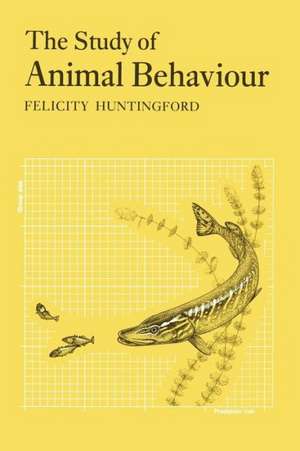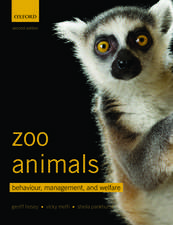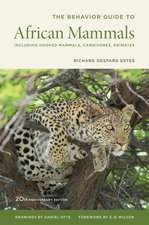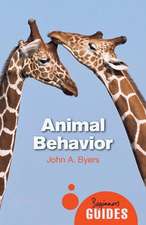The Study of Animal Behaviour
Editat de Felicity Huntingforden Limba Engleză Paperback – 26 ian 1984
Preț: 396.02 lei
Nou
Puncte Express: 594
Preț estimativ în valută:
75.79€ • 78.67$ • 63.19£
75.79€ • 78.67$ • 63.19£
Carte tipărită la comandă
Livrare economică 24 martie-07 aprilie
Preluare comenzi: 021 569.72.76
Specificații
ISBN-13: 9780412223303
ISBN-10: 0412223309
Pagini: 412
Ilustrații: XVI, 412 p. 23 illus.
Dimensiuni: 155 x 235 x 22 mm
Greutate: 0.6 kg
Editura: SPRINGER NETHERLANDS
Colecția Springer
Locul publicării:Dordrecht, Netherlands
ISBN-10: 0412223309
Pagini: 412
Ilustrații: XVI, 412 p. 23 illus.
Dimensiuni: 155 x 235 x 22 mm
Greutate: 0.6 kg
Editura: SPRINGER NETHERLANDS
Colecția Springer
Locul publicării:Dordrecht, Netherlands
Public țintă
ResearchCuprins
1 Introduction.- 1.1 The ethological approach to the study of behaviour.- 1.2 A brief outline of classical ethological theory.- 1.3 The modern study of animal behaviour.- 1.4 An outline of the book.- 2 The description and measurement of behaviour.- 2.1 Describing behaviour by its function.- 2.2 Describing behaviour by its form.- 2.3 Describing and measuring the relationship between an animal and its environment.- 2.4 What is the point of all this sophisticated analysis?.- 3 The study of the causes of behavioural change.- 3.1 What constitutes a causal explanation of behaviour?.- 3.2 The different kinds of causal explanation.- 3.3 Motivational models.- 3.4 Studying external influences on behaviour.- 3.5 Studying internal influences on behaviour.- 3.6 What is the nature of the mechanisms which cause behavioural change?.- 3.7 Studying the physiological bases of behavioural change.- 4 The development of behaviour.- 4.1 Problems with the instinct-learning dichotomy.- 4.2 Why is the term innate still used?.- 4.3 Describing the ontogeny of behaviour.- 4.4 Characterizing the factors which influence the development of behaviour.- 4.5 Classifying the factors which influence the development of behaviour.- 4.6 Some general features of behavioural development.- 5 The adaptive significance of behaviour.- 5.1 Sources of evidence about the adaptive significance of behaviour.- 5.2 Difficulties in studying the adaptive significance of behaviour.- 5.3 The state of the art.- 5.4 The adaptive significance of the way animals pattern their behavior in time.- 5.5 The adaptive significance of the way animals use space.- 5.6 The adaptive significance of an animal’s aggressive responses.- 5.7 The adaptive significance of an animal’s breeding habits; mating systems.- 5.8 Adaptive significance of behaviour accompanying mating.- 5.9 The adaptive significance of parental care.- 5.10 The adaptive significance of living in groups.- 5.11 Behaviour which cannot be explained by classic natural selection theory.- 5.12 Overview; sociobiology and behavioural ecology.- 6 The phylogeny of behaviour.- 6.1 Sources of evidence about the phylogeny of behaviour.- 6.2 Some representative behavioural phylogenies.- 6.3 Deriving general principles of behavioural evolution.- 7 The role of behaviour in the evolutionary process.- 7.1 The behaviour of other animals as a major selective force.- 7.2 Behaviour dictates the selection pressures to which an animal is exposed.- 7.3 The impact of behaviour on population structure.- 8 Behavioural genetics.- 8.1 The objectives of research into the inheritance of behaviour.- 8.2 Potential contributions of genetics to the study of animal behaviour.- 8.3 Quantitative genetics.- 8.5 Screening known genetic variants for behavioural differences.- 8.6 Characterizing the precise behavioural effects of genetic differences.- 8.7 The mechanisms whereby genes influence behaviour.- 8.8 Genetic mosaics.- 8.9 Animal behaviour and behavioural genetics.- 9 Applied ethology.- 9.1 Clarification of terms; what is applied ethology?.- 9.2 Ways in which etiological research can be applied to practical problems.- 9.3 Pest control.- 9.4 Increasing the productivity of commercially important species.- 9.5 Animal welfare.- 9.6 Conservation.- 9.7 Human behaviour.- References.- Author index.- Species index.
















